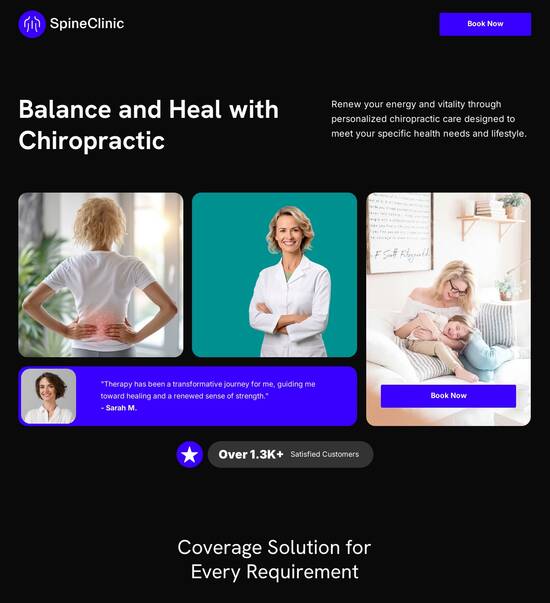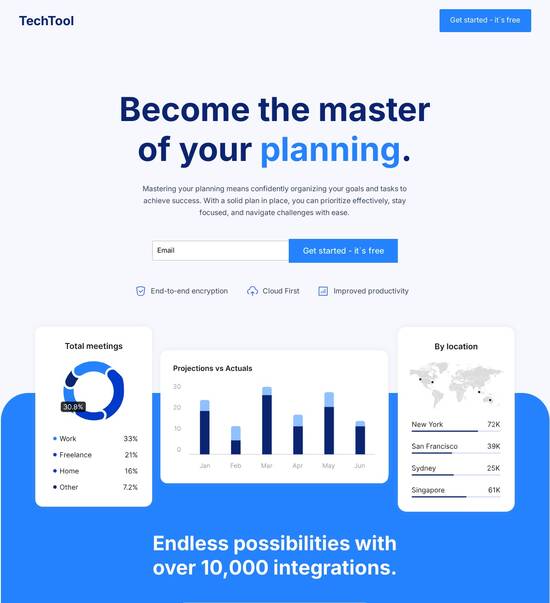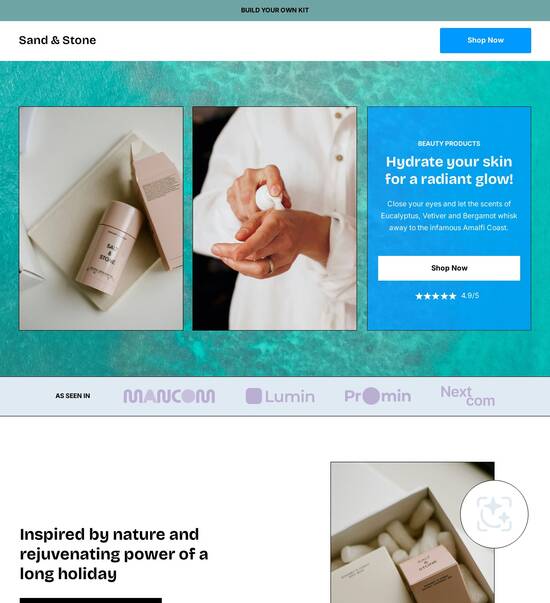
Story telling page template optimized for Google Pixel
Explore Similar TemplatesAbout template
Design using a responsive story telling page template that delivers a flawless experience on Google Pixel. Try Instapage today!
Recommended templates

Easy to build without coding
With the intuitive drag-and-drop builder, anyone on your team can create high-converting pages without any knowledge of code or design. Make enhancements to your landing page with custom widgets using Javascript, HTML/CSS, or third-party scripts.

Multiple layouts for any industry and goal
Select from 500+ landing page layouts built to boost conversions across industry-specific scenarios. Customize them by adjusting fonts, adding images, and generating on-brand content with the AI assistant. Quickly scale with Instablocks® and Global Blocks that you can save, reuse, and update globally.

Loads fast and looks polished on any device
Every template is responsive, which means they present professionally on any device and load blazingly fast with our Thor Render Engine. You can also power them up with Google AMP technology to deliver an unparalleled mobile experience and drive higher conversions.

Robust analytics & experimentation
Get real-time updates and reporting across all your devices, showing the number of visitors, conversions, cost-per-visitor, and cost-per-lead. Launch AI-powered experiments, run A/B tests, and use heatmaps to analyze user behavior, then optimize your landing page to maximize conversions.







Easy to build without coding
With the intuitive drag-and-drop builder, anyone on your team can create high-converting pages without any knowledge of code or design. Make enhancements to your landing page with custom widgets using Javascript, HTML/CSS, or third-party scripts.
Multiple layouts for any industry and goal
Select from 500+ landing page layouts built to boost conversions across industry-specific scenarios. Customize them by adjusting fonts, adding images, and generating on-brand content with the AI assistant. Quickly scale with Instablocks® and Global Blocks that you can save, reuse, and update globally.
Loads fast and looks polished on any device
Every template is responsive, which means they present professionally on any device and load blazingly fast with our Thor Render Engine.
Robust analytics & experimentation
Get real-time updates and reporting across all your devices, showing the number of visitors, conversions, cost-per-visitor, and cost-per-lead. Launch AI-powered experiments, run A/B tests, and use heatmaps to analyze user behavior, then optimize your landing page to maximize conversions.
All the features you need to build lead-generating landing pages
Explore more featuresLearn how to build top-performing landing pages for any goal
FAQs
Leading the way in building high-performing landing pages





Creating a high-impact landing page with Instapage
When it comes to enhancing your digital marketing strategy, using a high-quality landing page optimized for conversions is crucial. Instapage offers a comprehensive solution that not only simplifies the creation of landing pages but also empowers marketers to maximize their ROI effectively. With access to over 100 customizable templates and conversion elements, Instapage enables you to launch campaigns that capture leads effectively, all within a flexible environment designed for quick delivery.
Step 1: Choosing the Right Template
Selecting a high-performing template is the starting point for building a successful landing page. Instapage offers a diverse range of designs tailored for various industries. Once you've selected a template, here are some considerations:
- Choose a template suited to your audience, ensuring that the design aligns with your brand identity.
- Check the layout for mobile optimization to ensure a seamless experience across devices.
- Look for templates that allow for A/B testing functionalities to optimize performance over time.
Step 2: Utilizing Optimized Elements
After selecting your template, the next step involves integrating optimized lead generation elements. Here’s what you can do:
- Incorporate lead capture forms directly into your landing pages to minimize drop-offs and maximize conversions.
- Utilize Instablocks to add custom content pieces without needing any coding skills, boosting personalization on your page.
- Include high-quality images and streamlined CTA buttons that attract attention and drive action toward desired user behaviors.
Step 3: Implementing Personalization and Optimization
Customizing your landing page to meet the unique needs of each audience segment can significantly enhance engagement. Focus on:
- Using dynamic text replacement to personalize content based on user data for increased relevance.
- Connecting specific ads to tailored landing pages through Instapage's AdMaps for cohesive user journeys.
- Setting up detailed heatmaps and utilizing analytics to assess user engagement and improve conversion strategies.
By following these steps, your landing page not only becomes a powerful tool to convert leads, but it also functions seamlessly to optimize your digital marketing campaigns.
Embrace the versatility and power of Instapage's capabilities to achieve tangible results from your marketing efforts.
Ready to get started? Explore Instapage’s robust features today and watch your conversion rates soar!
Creating a storytelling page template optimized for Google Pixel
I. Understanding web stories: The future of digital storytelling
Web stories are quickly gaining prominence in the digital landscape as a tool for effective storytelling. These visually engaging formats present content in bite-sized, easy-to-consume pieces, catering to the modern viewer's fast-paced lifestyle. With their immersive qualities, web stories captivate audiences, allowing brands to tell their narratives in an impactful manner.
The rise in popularity of web stories can be attributed to their ability to blend creativity with technology, making narratives both engaging and accessible. This format appeals to marketers as it offers a fresh way to connect with audiences through interactive storytelling that encourages engagement and shares messages effectively.
Google Pixel devices enhance this experience with unique features designed for optimal storytelling. Equipped with top-tier cameras and advanced technology, the Pixel devices enable users to capture stunning visuals that elevate the overall narrative. Moreover, their seamless integration with Google services empowers creators to manage content easily, fostering creativity and efficiency.
II. The storytelling page template: Crafting engaging narratives
A well-crafted storytelling page template serves as the backbone for creating compelling narratives. It combines aesthetics with functionality, ensuring that each element works harmoniously to engage the reader. Essential components include a visually appealing layout, dynamic multimedia elements, and a coherent structure that guides users through the narrative flow.
The significance of beautiful design and interactive features cannot be overstated, as they significantly impact user engagement. Including visuals like images and videos not only enhances storytelling but also keeps the audience's attention. Interactive features facilitate deeper connections, making the viewing experience memorable and immersive.
Elements of a well-structured story page should include a strong narrative arc, engaging visuals, and clear call-to-action.
A beautiful design prioritizes user experience, ensuring easy navigation and readability.
Interactive features such as clickable elements will enhance audience participation and retention.
III. Best practices for creating effective web stories
Understanding your audience is the cornerstone of effective storytelling. Knowing what interests your readers and what resonates with them allows you to tailor your narratives accordingly. Conduct market research or use analytics tools to identify audience preferences, ensuring that your stories connect with the right demographic.
To maximize the impact of your story, it is crucial to structure it effectively. Employing a traditional story arc—beginning, middle, and end—provides clarity and maintains viewer engagement. Additionally, utilizing headings and bullet lists can enhance readability and draw attention to key points.
Craft authentic stories that align with audience interests.
Structuring narratives with a clear beginning, middle, and end helps maintain focus.
Incorporate interactive elements like quizzes and polls to keep users engaged.
IV. Design elements of a compelling storytelling page
Visual hierarchy is essential in design, as it directs the viewer’s attention to critical components of the story. Thoughtful choices regarding color schemes, font selection, and spacing can create a balanced and inviting aesthetic. By ensuring a seamless transition from one element to another, users are more likely to stay engaged and explore further.
User experience (UX) also needs close attention. A well-structured navigation system allows readers to follow your story intuitively, while strategies to enhance loading times and performance keep users content. In today's fast-paced digital world, slow-loading pages can lead to high bounce rates, so performance should not be overlooked.
Prioritize color palettes and font choices to maintain visual consistency.
Create a logical navigation path to facilitate easy exploration.
Optimize performance to minimize loading times, ensuring a pleasant user experience.
V. Leveraging Google Pixel’s features for storytelling
The Google Pixel smartphone features a powerful camera that significantly enhances storytelling capabilities. Users can take stunning visuals that boost the quality of their web stories. The exceptional image quality allows storytellers to capture details and moments that resonate with audiences, establishing a more profound connection through storytelling.
Additionally, Google's image editing tools provide users with resources for improving visuals without needing extensive technical knowledge. This functionality is especially beneficial for marketers looking to create polished, professional-grade content quickly. Integration with Google services like Google Drive and Google Analytics only adds to the Pixel's storytelling prowess, allowing for easy asset management and performance tracking.
Utilize the high-quality camera for capturing stunning visuals.
Employ image editing tools for refining storytelling elements.
Leverage Google Analytics for tracking story performance and audience engagement.
VI. Story metadata guidelines: Boosting discoverability and engagement
Metadata plays a crucial role in web stories as it enhances SEO and facilitates user experience. Proper tagging, descriptions, and categorization go a long way in boosting the visibility of your content in search engine results. Adding relevant metadata allows search engines to index your stories correctly, making it easier for potential readers to discover your material.
Essential metadata elements include title, description, and keywords. It is also advisable to include information about the category and versioning to help streamline content management. Structuring your stories with these guidelines ensures a robust approach to marketing your narratives effectively.
Incorporate relevant keywords to improve SEO and search visibility.
Use descriptive titles and summaries for better user engagement.
Maintain categorization for organizing stories efficiently.
VII. The impact of storytelling on landing pages
Storytelling can dramatically transform traditional landing pages, providing an opportunity to engage visitors more meaningfully. For instance, brands that successfully intertwine narrative techniques into their landing pages often see increased conversion rates. By presenting information in a relatable context, brands can foster deeper connections with their audience and enhance the overall user experience.
Successful case studies demonstrate how storytelling combined with informative content boosts engagement considerably. Brands that integrate narratives in meaningful ways are more likely to capture audience attention and encourage action. Additionally, monitoring performance metrics helps analyze the effectiveness of storytelling strategies, ensuring continuous refinement.
Case studies show that storytelling can significantly enhance landing page effectiveness.
Combine narrative techniques with information to increase conversions.
Track reader behavior and adapt strategies for better outcomes.
VIII. Crafting category pages with a storytelling approach
Implementing storytelling techniques on category pages offers various benefits, such as improving customer understanding of product categories. When users encounter narratives alongside product information, they gain a more comprehensive view, making it easier to relate and engage. This storytelling approach fosters deeper connections between customers and brands.
Highlighting featured products through storytelling can increase engagement and sales. Consider using testimonials or user-generated content as storytelling tools, as authentic reviews resonate well with potential customers. By creatively presenting categories, marketers can enhance customer journeys and drive conversions.
Narratives on category pages help enhance product understanding.
Employ storytelling to highlight featured products effectively.
Leverage testimonials to create authentic connections with users.
IX. Future trends in storytelling and page design
The future of storytelling is undoubtedly tied to evolving technologies and innovative approaches. As artificial intelligence becomes more sophisticated, content creation may be personalized to unprecedented levels, aligning narratives with individual user preferences. Furthermore, exploring augmented and virtual reality technologies can open doors to immersive storytelling experiences.
As we look at the broader digital landscape, businesses must remain adaptable to changing trends in web stories and landing pages. Predictions suggest a continuing shift toward interactive content, demanding that organizations stay ahead of the curve. By preparing now for future developments, businesses can ensure that their storytelling strategies remain relevant.
AI-driven content personalization will significantly enhance storytelling.
Augmented and virtual reality may transform how narratives are experienced.
Businesses must keep evolving to stay aligned with trends in web stories.
Ready to skyrocket conversions?
Supercharge your ad campaigns with high-performing landing pages
Get started














